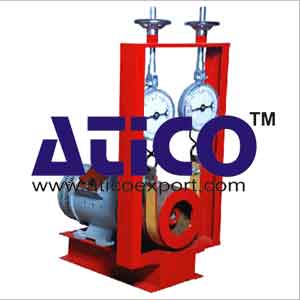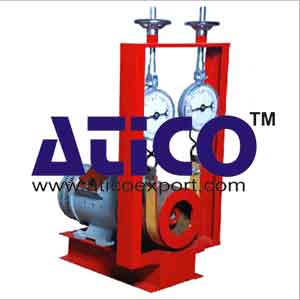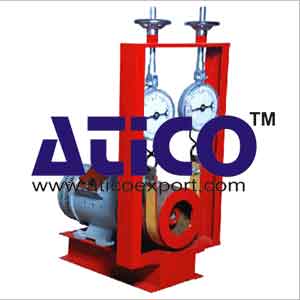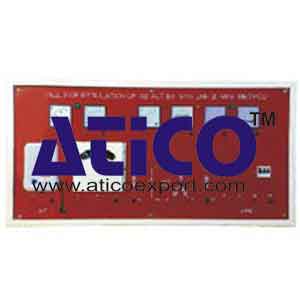Centrifugal Force Kit
Categories: Electrical Lab Testing EquipmentDescription This versatile kit is part of a series that allows many experiments using different arrangements of their parts. Students, teachers or lecturers fit the parts of the kit to the work panel...
Product
Description
Description
This versatile kit is part of a series that allows many experiments using different arrangements of their parts. Students, teachers or lecturers fit the parts of the kit to the work panel (supplied separately) to study or show an engineering science topic. This kit includes a manually rotated frame with a low friction cantilever linkage. The frame has mounting positions for adjustable masses and a spring that applies a fixed frictional force value to a rotating drum. The range of mounting positions and masses allows many variations of the experiment to help students understand the relationships between the variables of speed, mass and radial position. Students fi t the chosen masses to one side of the frame and an equal counterbalance to the opposite side of the frame. They rotate the assembly which will overcome the spring frictional force at a given speed, working as centrifugal clutch that regulates its own speed. The frame has a durable ‘clicking’ tab that students use with a stopwatch (supplied) to measure the speed. They use their measurements to calculate the forces due to the rotating masses and compare them with the opposing force from the spring. The kit introduces students to key engineering terms such as centrifugal and centripetal force, while explaining the fictitious term ‘centrifugal’ force and its accepted use. It also shows the use of ‘radians’ in rotational velocity measurement. we supplies a CD-ROM with the work panel. It includes all the worksheets, guidance notes and lecturer notes (with answers) needed for typical experiments with each kit. The selection of parts in the kits and the choice of fi xing points on the work panel means that teachers or lecturers may extend the experiments to an even greater range. Note: The kit is for use with the work panel (supplied separately)
Learning Outcomes
Relationship between centrifugal force, radius and velocity of diff erent rotating masses
Specifications
Atico is committed to a programme of continuous improvement; hence we reserve the right to alter the design and product specifi cation without prior notice.
Storage tray (with clip-on lid):
450 mm x 320 mm x 85 mm
Nett weight:
2.7 kg
Packed volume and weight:
Approximately 0.015 m3 and 3.2 kg
Main parts:
• Rotating frame
• Weight hanger and masses
• Stopwatch
Operating Conditions
Operating Enviroment:
Laboratory Enviroment
Storage Temprature Range :
–25°C to +55°C (when packed for transport)
Operating Temprature range:
+5°C to +40°C
Operating relative humidity range:
80% at temperatures < 31°C decreasing linearly to 50% at 40°C
quick overview :
Description
This versatile kit is part of a series that allows many experiments using different arrangements of their parts. Students, teachers or lecturers fit the parts of the kit to the work panel (supplied separately) to study or show an engineering science topic. This kit includes a manually rotated frame with a low friction cantilever linkage. The frame has mounting positions for adjustable masses and a spring that applies a fixed frictional force value to a rotating drum. The range of mounting positions and masses allows many variations of the experiment to help students understand the relationships between the variables of speed, mass and radial position. Students fi t the chosen masses to one side of the frame and an equal counterbalance to the opposite side of the frame. They rotate the assembly which will overcome the spring frictional force at a given speed, working as centrifugal clutch that regulates its own speed. The frame has a durable ‘clicking’ tab that students use with a stopwatch (supplied) to measure the speed. They use their measurements to calculate the forces due to the rotating masses and compare them with the opposing force from the spring. The kit introduces students to key engineering terms such as centrifugal and centripetal force, while explaining the fictitious term ‘centrifugal’ force and its accepted use. It also shows the use of ‘radians’ in rotational velocity measurement. we supplies a CD-ROM with the work panel. It includes all the worksheets, guidance notes and lecturer notes (with answers) needed for typical experiments with each kit. The selection of parts in the kits and the choice of fi xing points on the work panel means that teachers or lecturers may extend the experiments to an even greater range. Note: The kit is for use with the work panel (supplied separately)
Learning Outcomes
Relationship between centrifugal force, radius and velocity of diff erent rotating masses
Specifications
Atico is committed to a programme of continuous improvement; hence we reserve the right to alter the design and product specifi cation without prior notice.
Storage tray (with clip-on lid):
450 mm x 320 mm x 85 mm
Nett weight:
2.7 kg
Packed volume and weight:
Approximately 0.015 m3 and 3.2 kg
Main parts:
• Rotating frame
• Weight hanger and masses
• Stopwatch
Operating Conditions
Operating Enviroment:
Laboratory Enviroment
Storage Temprature Range :
–25°C to +55°C (when packed for transport)
Operating Temprature range:
+5°C to +40°C
Operating relative humidity range:
80% at temperatures < 31°C decreasing linearly to 50% at 40°C
Product
Reviews
add Review
reviews
No Review Yet.
Copyrights © 2025 All Rights Reserved by Atico














Product
Reviews
add Review
reviews
No Review Yet.